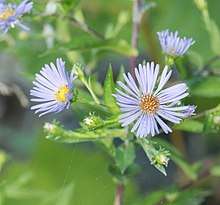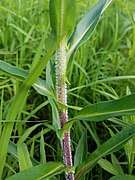Symphyotrichum puniceum
Symphyotrichum puniceum (formerly Aster puniceus), commonly known as purplestem aster,[2] red-stalk aster,[3] red-stemmed aster or swamp aster, is a perennial herb native to eastern North America. It has also been called early purple aster and meadow scabish.
| Symphyotrichum puniceum | |
|---|---|
 | |
| In Beaver County, Pennsylvania | |
| Scientific classification | |
| Kingdom: | Plantae |
| Clade: | Tracheophytes |
| Clade: | Angiosperms |
| Clade: | Eudicots |
| Clade: | Asterids |
| Order: | Asterales |
| Family: | Asteraceae |
| Genus: | Symphyotrichum |
| Subgenus: | Symphyotrichum subg. Symphyotrichum |
| Section: | Symphyotrichum sect. Symphyotrichum |
| Species: | S. puniceum |
| Binomial name | |
| Symphyotrichum puniceum | |
| Synonyms[1] | |
| |
It is one of the widest ranging plants of the genus, being present from the edges of the Great Plains to the Atlantic coast and from the Gulf coast of Texas north to southern Ungava Bay in the north of Quebec.[2] It is adventive in Europe.[1]
Taxonomy
Symphyotrichum puniceum is a variable species and many forms have been named.[4] Two varieties are currently accepted:[1][5]
- Symphyotrichum puniceum var. puniceum — most of the eastern United States and southern Canada
- Symphyotrichum puniceum var. scabricaule (Shinners) G.L.Nesom – southern United States from Texas to Alabama
The species Symphyotrichum firmum is sometimes considered a variety of S. puniceum, but most sources treat them as distinct species.[5][6] Compared to S. firmum, this species is typically hairier, with purpler flowers, and does not form dense colonies but rather small clusters or scattered individuals.[7]
Description
It produces flowers between August and October. The ray florets range from dark blue or purple to white (rarely). The disc florets are yellow to cream-colored, becoming pink or purple with maturity.[5]
 Stem and leaves
Stem and leaves Flowerhead
Flowerhead Flowerheads
Flowerheads
References
- "Symphyotrichum puniceum". Plants of the World Online. Royal Botanical Gardens Kew. Retrieved 2018-10-03.
- "Symphyotrichum puniceum". Natural Resources Conservation Service PLANTS Database. USDA. Retrieved 7 December 2015.
- "BSBI List 2007". Botanical Society of Britain and Ireland. Archived from the original (xls) on 2015-01-25. Retrieved 2014-10-17.
- "Aster puniceus". ipni.org. International Plant Names Index. Retrieved 2018-10-03.
- Brouillet, Luc; Semple, John C.; Allen, Geraldine A.; Chambers, Kenton L.; Sundberg, Scott D. (2006). "Symphyotrichum puniceum". In Flora of North America Editorial Committee (ed.). Flora of North America North of Mexico (FNA). 20. New York and Oxford – via eFloras.org, Missouri Botanical Garden, St. Louis, MO & Harvard University Herbaria, Cambridge, MA.
- Warners, David P.; Laughlin, David C. (1999). "Evidence for a species-level distinction of two co-occurring asters: Aster puniceus L. and Aster firmus Nees". Great Lakes Botanist. 38 (2).
- Reznicek, A. A.; Voss, E. G.; Walters, B. S. "Symphyotrichum". Michigan Flora Online. University of Michigan. Retrieved 8 January 2020.